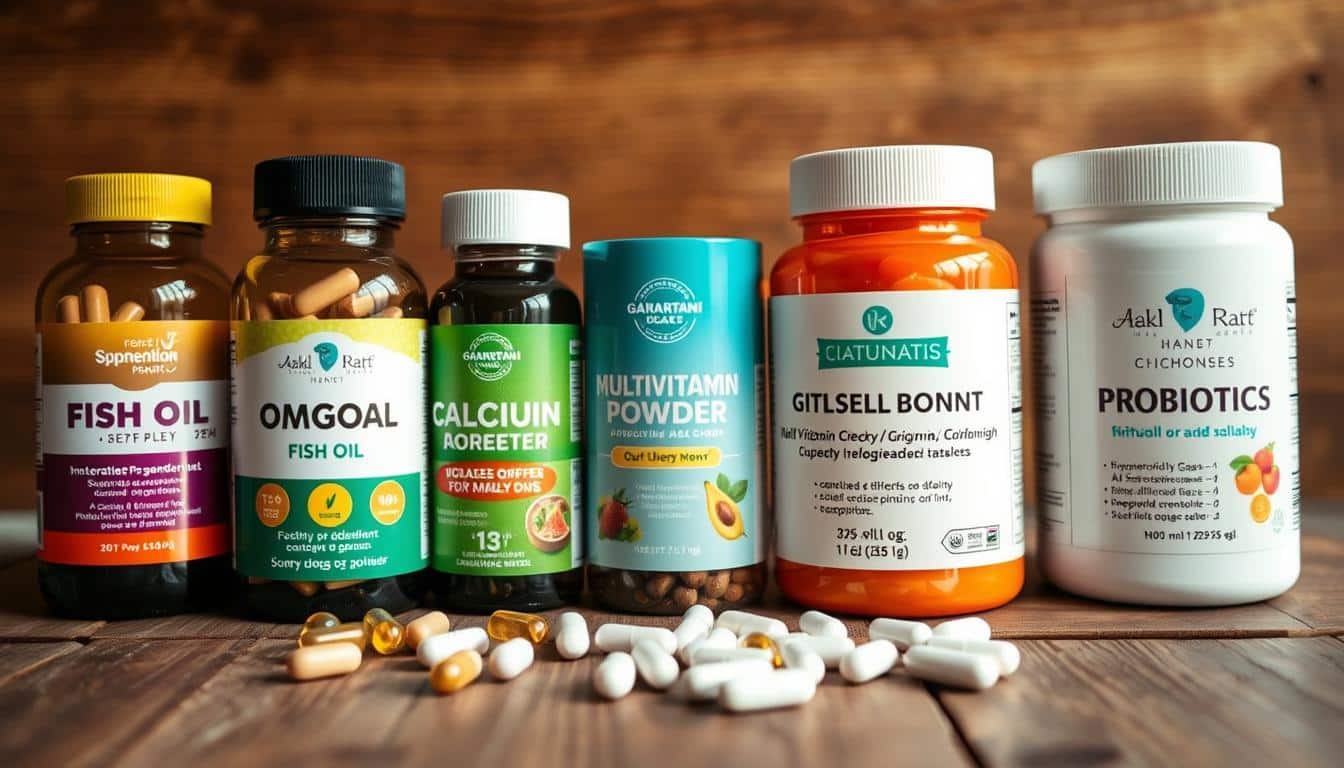This guide provides expert advice on using Omega-3 rich meals to help itchy Shih Tzus. You’ll learn how to make homemade dog food that fights allergies. Also, discover the right way to use fish oil and how much food is good for small dogs like the Shih Tzu.
Making your dog’s food can avoid ingredients that often cause allergies. You can make sure your dog gets important nutrients like EPA and DHA, lean proteins, and antioxidants. This means less inflammation and quicker relief for your Shih Tzu’s skin.
Feeding tips include creating balanced meals that fit your small dog’s size. Aim to feed 1/2–1 cup per day for every 5–10 lb of weight. This diet plan for itchy Shih Tzus helps control portions and makes adding supplements easy.
The guide will later explain how to choose and use supplements like fish oil, probiotics, and quercetin. But, always talk to a vet before making big changes to ensure your dog’s diet is safe and right for them.
Understanding Shih Tzu Skin Allergies and Itching
Many Shih Tzu owners see their pets itch and find it hard to know why. Taking clear steps and watching closely helps identify if the issue is food, fleas, or something in the environment. A vet can guide you toward the right tests and treatments.
Common causes of itching in Shih Tzus
- While not as frequent, food reactions can deeply bother your pet; figuring this out usually means cutting out certain foods over time.
- Things like pollen, dust mites, and mold can make dogs itch. This can happen all year or just at certain times.
- If your dog itches a lot around its tail or lower body, fleas might be the problem.
- Too much scratching can lead to skin infections from bacteria or yeast, making the itching even worse.
Symptoms to watch for: paws, ears, face, and recurrent infections
- When a dog can’t stop scratching its paws or loses fur on its legs, it’s a sign of something chronic.
- If your dog often has ear problems, rubs its face a lot, or has itchy eyes, it might be allergic.
- Chewing on one spot until it’s red and raw often means there’s a skin infection that needs treatment.
- Throwing up or diarrhea along with skin issues could mean your dog has a food allergy.
When to see the veterinarian: diagnosing food vs environmental allergies
- A thorough check-up and history by a vet can help pinpoint the problem and eliminate other causes like parasites.
- If food is suspected, vets often suggest a special diet with unique proteins for a while to see if it helps.
- Testing the skin or blood can uncover what environmental factors might be irritating your dog, offering clues for treatment.
- Location of the itching can hint at the cause: near the tail suggests fleas, while issues that happen all over or year-round might be food related.
- Before you try a new diet or supplement, always get advice from your vet to ensure treatment is safe and effective.
The role of inflammation and diet in canine skin health
Skin problems in Shih Tzus often come from chronic inflammation. Diet is very important in this. Choosing the right foods can lower inflammation, ease itching, and make their coat look better.
How ultra-processed diets can increase inflammatory burden
Many commercial kibbles are over-processed. They contain additives, refined carbs, and heat-damaged proteins. Studies and experts say these can increase inflammation and lead to obesity.
Obesity makes inflammation worse. More than half of pets in the U.S. are too heavy. Too much fat releases molecules that make skin problems harder to manage.
Why reducing systemic inflammation helps relieve itching
Reducing inflammation can make skin nerves less sensitive. It also calms the immune responses that cause redness and itch. An anti-inflammatory diet with whole foods and certain fats can reduce flare-ups.
Adding omega-3 fatty acids helps too. They change immune signals to be less inflammatory. This means less cytokine production and calmer skin.
Pet-iterranean-style eating for dogs: principles and benefits
The Pet-iterranean diet adjusts Mediterranean eating habits for dogs. It uses whole foods, lean meats like salmon, safe vegetables, whole grains, and omega-3 rich fats.
- Principles: whole foods, limited processed meats, controlled portions, and varied protein sources.
- Benefits: improved skin and coat, fewer allergic reactions, and better weight management with correct portions.
- Practical tip: Combine this diet with advice from your vet or a pet nutrition expert. This ensures your small breed dog gets the nutrients it needs.
Key nutrients for itchy Shih Tzus: Why Omega-3s matter
Short-term relief for an itchy Shih Tzu often starts with good nutrition. Good nutrients help repair the skin, reduce swelling, and make the coat shiny. Here, we’ll talk about the best nutrients for your dog’s diet and where to find them.
Omega-3 fatty acids: EPA and DHA benefits for skin and immune health
EPA and DHA are omega-3 fats that help reduce inflammation and heal skin. Research shows they help dogs by lessening itching and reducing allergy flare-ups. These fats are best gotten from marine oils, which are more effective than plant sources.
Additional skin-supporting nutrients: antioxidants, zinc, vitamin E, and biotin
Antioxidants found in fruits and vegetables help protect dog skin by fighting damage. Zinc helps with healing and immune health. Vitamin E guards cell walls and makes the coat shine. Biotin aids in skin and hair growth. Together, these nutrients work alongside omega-3s for better skin health.
Sources of omega-3s appropriate for dogs: fish oil, salmon, sardines, and flax
- Fish oil for Shih Tzu: high-quality fish oil supplements provide EPA and DHA. Choose products tested for heavy metals and PCBs.
- Salmon oil dog sources: salmon oil from reputable sources offers EPA/DHA and tastes good for picky eaters.
- Whole canned fish: water-packed salmon or sardines are good sources of EPA and DHA. Use them carefully to keep calories and sodium in check.
- Flax and flaxseed oil: although ALA from plants converts less efficiently, it’s still useful. But it shouldn’t be the main source for itching due to allergies.
When picking products, focus on purity, dosage clarity, and direct EPA/DHA amounts. For small dogs like Shih Tzus, begin with small doses. Observe changes in their coat and skin. Mixing marine omega-3s with antioxidants, zinc, vitamin E, and biotin can help reduce itching and improve comfort.
Omega-3 rich meals for itchy Shih Tzus
Feeding a Shih Tzu the right foods can help with skin problems. You can make homemade omega-3 dog meals. This lets you manage ingredients and how much you feed. Start with lean fish or poultry. Add a soft grain like quinoa. Include anti-inflammatory veggies, and top it off with fish or salmon oil for extra omega-3s.
How to build balanced homemade meals for small breeds
Begin meal plans for small dogs with protein. Opt for salmon, whitefish, or turkey because they’re easy to digest and rich in omega-3. Then, mix in cooked quinoa or brown rice for energy. For fiber and nutrients, add steamed carrots, green beans, or mashed sweet potatoes.
- Protein: cooked salmon, whitefish, or ground turkey.
- Carbohydrate: quinoa or brown rice, well cooked.
- Veggies: carrots, green beans, peas, or sweet potato.
- Fats & supplements: a safe dose of fish oil and a canine vitamin/mineral premix such as HICC Pet or Holistic Vet Blend.
Sample meal ideas emphasizing fish, quinoa, and anti-inflammatory veggies
Create small portion meals so your Shih Tzu eats without leftovers. A good start is 1/2 cup per 10 lbs. Adjust the amount based on their activity and health.
- Salmon and Quinoa Medley: flaked cooked salmon + cooked quinoa + steamed carrots + green beans. This recipe is good for their protein and omega-3 needs.
- Whitefish and Carrot Mix: baked whitefish + steamed carrots + brown rice + a bit of fish oil for extra omega-3s.
- Turkey and Sweet Potato Delight: lean ground turkey + mashed sweet potato + peas + a teaspoon of olive oil for taste and healthy fats.
How much omega-3 (fish oil) to add safely for Shih Tzus
Fish oil amounts vary by the dog’s size and the oil’s concentration. Start with a small dose of purified fish oil in their food. Watch how they react through their stool and coat.
Start with about 1 teaspoon to 1 tablespoon of fish oil for every few cups of food. Adjust based on your dog’s size. Check their stool and skin. It’s best to talk to your vet for exact advice on omega-3 amounts. Choose fish oil that’s free from heavy metals and skip fish liver oils that have too much vitamin A.
Planning meals carefully for your small dog can make a big difference. Try recipes like the salmon quinoa dish and others that fight inflammation. Keep an eye on how your dog’s skin improves over time. Always work with your vet or a nutritionist to make sure the fish oil amount is just right.
Top homemade recipes with omega-3s that soothe itchy skin
Try these four simple recipes that use soft proteins and omega-3s to ease itchy skin. They’re perfect for small dogs like Shih Tzus and include a vet-recommended vitamin/mineral mix. Change up the meals and keep an eye on your dog’s digestion and coat.
Salmon and Quinoa Medley adapted for Shih Tzu portion sizes
Mix cooked, boneless salmon with quinoa and veggies for a meal that fights inflammation. Use 1/2 cup of salmon and quinoa each, and 1/4 cup of carrots and green beans. For a little dog, give about 1/4–1/2 cup per meal, based on their size and energy.
Make sure the salmon is cooked and cool before your dog eats it. This recipe provides healthy fats and proteins, making it easy on your dog’s stomach.
Whitefish and Carrot Mix with added fish oil for extra EPA/DHA
Whitefish, carrots, and brown rice come together in this gentle meal for dogs with sensitive stomachs. Start with 1/2 cup fish, and 1/4 cup each of carrots and rice, plus a bit of fish oil. Adjust portions for small dogs and divide into daily meals.
Add the fish oil when serving, or mix it into the batch. Keep an eye on your dog’s digestion when you add more oil. This meal is easy on allergies and high in omega-3s for healthy skin.
Instant Pot turkey, kale, and fish oil blend for convenience and balance
Create a nutrient-rich base using turkey, kale, carrots, quinoa, and bone broth in an Instant Pot. First, cook the turkey, then add the rest, pressure cook, and let it cool. Next, mix in some omega-3s like fish oil or canned sardines, and add a vitamin/mineral mix for dogs.
Adjust the amount for small dogs like Shih Tzus. This meal packs protein, veggies, and omega-3s and is simple to make.
Homemade bone broth as a soothing topper and nutrient booster
Cook bones for 8–24 hours with some veggies, then strain and cool. Freeze it in daily amounts and use it warm on your dog’s food. Bone broth boosts hydration, offers nutrients, and can make picky dogs more interested in their meals.
Use it as an extra, not the only food, and mix it with a vitamin/mineral blend. This helps prevent any missing nutrients in your dog’s homemade meals.
- Keep meals balanced with a vet-recommended premix to prevent nutrient shortfalls.
- Introduce new recipes slowly over 7–10 days to monitor tolerance.
- Rotate salmon, whitefish, and turkey meals to reduce risk of single-protein sensitivity.
Supplements and functional ingredients to pair with omega-3 meals
Adding the right supplements can make omega-3 meals even better for itchy Shih Tzus. It’s key to pick products tested for purity that show the EPA and DHA levels clearly. Small, steady changes are best.

Salmon oil and high-quality fish oils
- Choose third-party tested salmon oil or fish oil from Norway or Iceland if you can. These places usually have fewer pollutants.
- Look for products that clearly list EPA/DHA amounts and are tested for heavy metals or PCBs. Go for pet-specific brands like iHeartDogs and Holistic Vet Blend for easy dosing.
- Compare to find the highest quality fish oil for your dog, focusing on purity, concentration, and packaging that stops oxidation.
Probiotics, colostrum, and quercetin for immune balance
- Probiotics are great for fixing gut health and boosting immune tolerance. Pick strains proven to work for pets, especially with skin conditions.
- Colostrum provides important immune support and might help with allergic reactions. There are many soft-chew colostrum supplements; ask your vet about the right amount.
- Quercetin is a natural plant compound in some allergy formulas for dogs. It helps control allergy symptoms by acting like a natural antihistamine.
Reishi, apple cider vinegar, and complementary aids
- Reishi mushrooms can help with inflammation and support the liver and immune system.
- Apple cider vinegar can be used carefully on the skin or taken in small, diluted doses for its antibacterial benefits. Always check with your vet first.
- Consider also green-lipped mussel oil, collagen or bone-broth toppers, and balanced diet premixes like HICC Pet or Holistic Vet Blend.
Always talk to your vet before trying new supplements, especially when mixing different types like salmon oil and probiotics or colostrum. A plan made just for your dog is safer and more likely to improve itching.
Transitioning your Shih Tzu to homemade omega-3 meals safely
Switching your dog’s food needs planning and patience. Doing it slowly helps avoid upset stomachs and lets you watch for allergies. Begin by adding a bit of new food to their usual meals. Then, increase the new food amount over 7 to 10 days. This is important, especially if your pet has a sensitive stomach.
-
Stepwise mixing plan: Start with 25% new food for the first three days. Then, make it half and half. By Day 7, increase new food to 75%. After that, you can switch completely. If your dog reacts badly, take more time at each step.
-
Watch for signs: Look out for changes in poop, energy, and skin. Be alert for vomiting or diarrhea. If you notice anything, talk to your vet about it.
Gradual switching strategies to avoid digestive upset
When moving to homemade food, introduce new items one at a time. Begin with one meal change. Stick to familiar foods like salmon or turkey. Add new foods like quinoa or kale later.
Adding probiotics can help during this time. They help your dog’s stomach adjust to new, omega-3 rich foods.
Portion guidelines and caloric considerations for Shih Tzu body weight
Feed your Shih Tzu according to their size and how active they are. A basic rule is 1/2 cup of food per 10 pounds. Here’s a simple guide: for dogs 5–10 lbs, give 1/2 to 1 cup each day. For those 11–25 lbs, 1 to 3 cups.
Change portions based on age, whether they’re fixed, and how much they move. Keep an eye on their body and weigh them often. Remember, even similar small dogs may need different food amounts.
Working with your veterinarian or a veterinary nutritionist to ensure balance
Talk to your vet before changing diets. They can check for health issues that might change how your dog reacts to the new diet. Plan with a vet nutritionist for long-term feeding. This ensures your homemade meals meet all your dog’s needs.
Consider supplements to make sure your dog gets all needed nutrients. Keep track of what you’re feeding them and their weight to adjust as needed.
A careful approach and expert advice can make switching to homemade food positive. It can lead to better skin and a happier stomach for your Shih Tzu.
Practical tips to reduce environmental triggers alongside diet
A healthy diet is essential for Shih Tzus with itchy skin, but don’t forget about the home. Taking steps to reduce fleas, dust, and pollen makes a big difference. By doing a bit every day and cleaning deeply once a month, you’ll see better results.
- Start with a vet-approved flea treatment for both your pet and your home. Trusted brands like Frontline or Comfortis work well to prevent new flea problems.
- Groom your dog regularly to help with itchy skin. Brushing gently and giving short baths with recommended shampoo will ease irritation.
- Keep items like coconut oil wipes or sprays handy to calm hot spots between baths. Your vet can suggest medicated shampoos for infections.
Reducing household allergens
- Vacuum busy areas at least twice a week with a HEPA vacuum. Once a month, steam-clean your carpets and furniture.
- Wash all bedding, blankets, and toys in hot water every week. Use a HEPA air purifier to cut down on dust and pollen.
- If fleas are a problem, treat your home with trusted sprays or products. Always follow the advice of the product’s maker and your vet.
- Avoid strong smells and harsh chemicals. Choose gentle, unscented cleaning products to help your dog’s skin stay calm.
Monitoring progress and expected timelines
- Keep a simple record of how often your dog scratches, any ear infections, and changes in its stool and coat.
- Improvements in skin and coat from omega-3s and a cleaner home should appear in a few weeks. An elimination diet might show full benefits after a few months.
- Watch for any signs that things are getting worse and might need a vet’s attention. Keeping notes makes it easier to see progress and decide when it’s time for a vet visit.
By combining ongoing flea controls, careful grooming, reducing allergens at home, and keeping track of progress, you can help your dog feel better. Small, consistent efforts lead to long-lasting comfort.
Conclusion
Providing meals rich in omega-3 for itchy Shih Tzus can help. Choose fish-based proteins, quinoa, anti-inflammatory veggies, and tested fish oil. These ingredients reduce inflammation and improve itchiness and coat health. Try making a Salmon & Quinoa Medley. Use quality salmon oil for EPA and DHA that aid skin and immune health.
An all-round care plan works best. Mix a good diet with specific supplements like probiotics and colostrum. Add in quercetin, reishi, flea prevention, and regular grooming. This holistic strategy lessens environmental triggers and helps skin heal faster. It also works well with soothing skin treatments.
Always work with your vet for proper tests and diet changes. Use the right fish oil dose. For dogs with long-term allergies, switch to homemade meals slowly. Watch your dog’s health for weeks or months. Talk to your vet if things don’t get better. This careful, informed method offers Shih Tzus a great chance for healthier skin and comfort.
FAQ
What causes persistent itching in Shih Tzus?
How can diet reduce my Shih Tzu’s itching?
Why are omega-3s important for itchy dogs?
Which omega-3 sources are best for Shih Tzus?
Can homemade meals really help allergies better than kibble?
How do I build a balanced homemade meal for a small-breed Shih Tzu?
What are practical sample meals I can try?
How much fish oil should I add to a Shih Tzu’s diet?
Are there safety concerns with fish oil or homemade diets?
What supplements and functional ingredients complement omega-3 meals?
How should I transition my Shih Tzu to homemade food?
How long until I see skin or coat improvements after diet changes?
When should I involve my veterinarian or a veterinary nutritionist?
What non-diet measures should I use alongside nutrition?
How can I tell if itching is from fleas versus environment or food?
Should I worry about my Shih Tzu gaining weight on homemade meals?
What are safe, easy toppers or additions to soothe irritated skin and GI tract?
How do antioxidants and micronutrients help skin health?
Which household cleaning steps reduce environmental allergy triggers?
If my Shih Tzu doesn’t improve, what should I do next?
Content created with the help of Artificial Intelligence.



